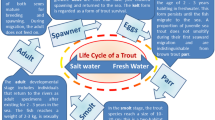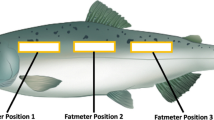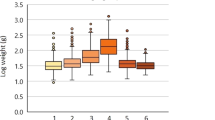Abstract
DURING a recent expedition of the R/V Alpha Helix (1968), we had the opportunity to compare blood serum lipids of pink salmon (Oncorhynchus gorbuscha) collected at two points in their spawning migration. Fish were sampled from commercial purse seines near Namu, which is located on the British Columbia coast at the entrance to the Burke Channel; and again 60 miles from the sea in a small freshwater stream (a tributary of Thomsons Creek) near Bella Coola, at the head of the same channel. The fish were spawning at this latter site and were obtained by dip net. The principal difference between the Namu and Thomsons Creek fish was that the latter had undertaken a migration of 60 miles under total fasting conditions. The Namu fish were in good condition while those in the freshwater stream had lost on average one-third of their weight and were close to death. Other studies1–4 have demonstrated that salmon lose weight during the spawning migration. It is known that lipids are the principal substrate in the energy metabolism offish and that 91 to 96 per cent of the fat reserve in the salmon is utilized during this migration1. Ultrastructural observations (to be published) confirmed that lipid deposits had disappeared from the back muscle of the salmon after migration.
This is a preview of subscription content, access via your institution
Access options
Subscribe to this journal
Receive 51 print issues and online access
$199.00 per year
only $3.90 per issue
Buy this article
- Purchase on Springer Link
- Instant access to full article PDF
Prices may be subject to local taxes which are calculated during checkout
Similar content being viewed by others
References
Tashima, L., and Cahill, jun., G. F., in Handbook of Physiology (edit. by Renold, A. E., and Cahill, jun., G. F.), 5, 55 (Amer. Physiol. Soc., Washington, 1965).
Idler, D. R., and Tsuyuki, H., Canad. J. Biochem. Physiol., 36, 783 (1958).
Idler, D. R., and Bitner, I., J. Fish. Res. Board Canada, 16, 235 (1959).
Hoar, W. S., in The Physiology of Fishes (edit. by Brown, M. E.), 1, 304 (Academic Press, New York, 1957).
Folch, J., Lees, M., and Sloane-Stanley, G. H., J. Biol. Chem., 226, 497 (1957).
Abell, L. L., Levy, B. B., Brodie, B. B., and Kendall, F. E., J. Biol. Chem., 195, 357 (1952).
Rouser, G. N., Siakotos, A. N., and Fleischer, S., Lipids, 1, 85 (1966).
Stern, I., and Shapiro, B., J. Clin. Path., 6, 158 (1953).
Duncombe, W. G., Biochem. J., 88, 7 (1963).
Bilinski, E., and Gardner, L. J., J. Fish. Res. Board Canada, 25, 1555 (1968).
Author information
Authors and Affiliations
Rights and permissions
About this article
Cite this article
PATTON, S., CROZIER, G. & BENSON, A. Serum Lipids and the Death of Spawning Pacific Salmon. Nature 225, 754–755 (1970). https://doi.org/10.1038/225754b0
Received:
Revised:
Issue Date:
DOI: https://doi.org/10.1038/225754b0
This article is cited by
-
Physiological comparisons of steelhead kelts emigrating from the Situk River, AK and Clearwater River, ID
Environmental Biology of Fishes (2016)
-
Skeletal lipid depletion in spawning salmon
Lipids (1989)
-
Liver triglyceride synthesis failure in post‐spawning salmon
Lipids (1971)
Comments
By submitting a comment you agree to abide by our Terms and Community Guidelines. If you find something abusive or that does not comply with our terms or guidelines please flag it as inappropriate.



